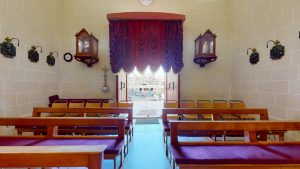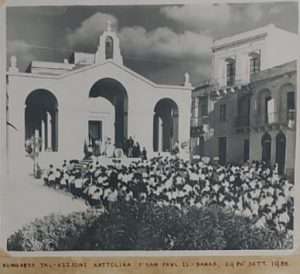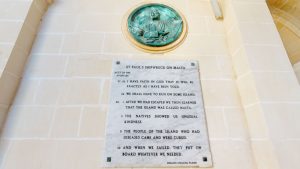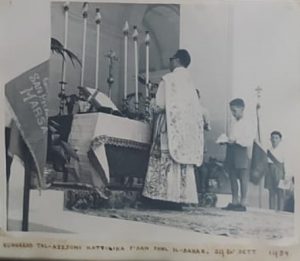
WELCOME!
to
The Chapel of St. Paul Shipwrecked

The Shipwreck of St Paul Church is a national shrine. It stands where many believe the saint and his companions were welcomed by the Maltese and where a large fire was lit.

It is unknown when the first church was built on the site or in the surrounding area, but according to local legend, it was not long after the shipwreck. The church was possibly destroyed by the Arabs and rebuilt following the Norman conquest of Malta. The church was endowed with rents from nearby buildings as well as rents from the nearby Burmarrad fief. It was abandoned over time, most likely in the fourteenth century, by the Bordino and Desguanez families rebuilt it. It’s possible that this chapel is what gave the bay its name, St Paul’s Bay.
Bernardo Janer, Dean of the Chapter of Mdina, rebuilt the old church and bestowed a pious benefice on it in 1442. In his diary, Jesuit Fr Girolamo Manduca (1573-1643) noted seeing the armorial shields of the De Nava and Mazzara families, who restored the church at their own expense. In his report on the state of the Maltese islands dated 1536, Johannes A.E. Quintinus, the auditor of Grand Master L’ Isle Adam, wrote, “Maltese sailors include Paul in the history of their land: above all, they point at and venerate his footsteps in many places.” The shore of that place, which is located between two seas, can be visited (according to Ptolemy, it is called Chersonenses, which it is); it has derived its name from Paul since it is the location of the shipwreck. There is a small stone chapel that is highly revered.’
Mgr. Pietro Dusina made an apostolic visit to St Paul’s Bay in 1575, which was part of the nearly uninhabited parish of Melliea at the time. The Moors had wreaked havoc on this unprotected region. Dusina discovered eleven chapels in the Melliea area, the majority of which were partially demolished. The church of St Paul’s Shipwreck was in disrepair and had been grossly neglected. Certain noble families’ coats of arms, such as the Bordino and Desguanez families, remained in use until 1610. The chapel must have been owned by the Cathedral because it is non fu di guspatronato. This means that no specific person or entity had a legal claim to the chapel.
to St Paul’s Bay in 1575, which was part of the nearly uninhabited parish of Melliea at the time. The Moors had wreaked havoc on this unprotected region. Dusina discovered eleven chapels in the Melliea area, the majority of which were partially demolished. The church of St Paul’s Shipwreck was in disrepair and had been grossly neglected. Certain noble families’ coats of arms, such as the Bordino and Desguanez families, remained in use until 1610. The chapel must have been owned by the Cathedral because it is non fu di guspatronato. This means that no specific person or entity had a legal claim to the chapel.
Although Grand Master Wignacourt had a genuine love for the saint, the order of St John wanted to increase the Pauline Heritage on the islands in order to increase their popularity among the inhabitants. The only chapel in the area at the time was close to where the Wignacourt Tower now stands. On November 6, 1609, Grand Master Alof de Wignacourt convened the Order’s Council to discuss the construction of a number of watch towers, one of which would be located in St Paul’s Bay. The plan was presumably trusted to Vittorio Cassar, who believed it had to be built where the church of St Paul once stood. As a result, it was decided that another church dedicated to the saint would have to be built nearby. A ceremony was thus held, attended by the Grand Master and Bishop Tommaso Gargallo, during which a stone from the old church was removed. After singing the Te Deum, the Bishop celebrated holy mass for the final time on the altar and directed the cortege while carrying it in procession.” The stone was then carried in procession to the site of the new church, where it still stands today. It was blessed and prayed over before being used as the first stone of the new church. The Bishop and Grand Master buried coins and medals beneath it.
 The church was initially under the jurisdiction of the Bishop, and Fr Leonardo Abela was the Rector at the time. The church took several years to build. Grand Master Wignacourt wished to unite Rabat’s Chapel of St Paul and Grotto of St Paul under one Foundation.
The church was initially under the jurisdiction of the Bishop, and Fr Leonardo Abela was the Rector at the time. The church took several years to build. Grand Master Wignacourt wished to unite Rabat’s Chapel of St Paul and Grotto of St Paul under one Foundation.
During this time, a Spanish hermit named Juan Benegas de Cordoba lived near the grotto and obtained permission to look after it and increase its international devotion. Beneguas and the Grand Master began putting pressure on the Pope in Rome to establish the Foundation. Grand Master Wignacourt desired to purchase land in order to fund the chapel and grotto with the proceeds from these purchases. He also intended to include the ecclesiastical benefice of the chapel itself in these profits, but when he realized that obtaining such permission would be difficult, he decided to contribute his own money to the cause.
These negotiations must have taken a long time because when Bishop Cagliares paid a pastoral visit on 13 May 1615, he wrote in Malta that the chapel’s construction was still in its early stages and directed the beneficiary, Fr Leonardo Abela, to include a cemetery around the chapel. On May 23, 1616, Bishop Baldassare Cagliares (1615-1633) delegated his Vicar General Canon John Baptist Psaila to visit the churches of St Paul’s Bay. In the same year, Grand Master Wignacourt planned to rebuild St Paul’s Shipwreck Church. Canon John Habela, a canon of Mdina Cathedral, was the church’s beneficiary at the time.
time because when Bishop Cagliares paid a pastoral visit on 13 May 1615, he wrote in Malta that the chapel’s construction was still in its early stages and directed the beneficiary, Fr Leonardo Abela, to include a cemetery around the chapel. On May 23, 1616, Bishop Baldassare Cagliares (1615-1633) delegated his Vicar General Canon John Baptist Psaila to visit the churches of St Paul’s Bay. In the same year, Grand Master Wignacourt planned to rebuild St Paul’s Shipwreck Church. Canon John Habela, a canon of Mdina Cathedral, was the church’s beneficiary at the time.
The new church, which was built not far from the old one, was completed in 1616.
St. Paul’s Bay
Archaeological relics dating back to roughly 4000 BC have been discovered inside the confines of St. Paul’s Bay. Among the ruins are the megalithic temples of Buibba and Xemxija. Cart Ruts were also discovered on the Wardija Ridge in Busewdien, as well as Punic tombs and other Bronze Age relics. St. Paul’s Bay grew in importance throughout the Roman era. Xemxija has discovered the remains of a Roman road, baths, and beehives, as well as Roman anchors on the seafloor.
St. Paul’s Bay was abandoned during the late Middle Ages because the region was hazardous owing to corsair assaults. The local militia kept multiple watch stations in the region. One of them, known as the Ta’ Tabibu farmhouse, is still standing today and is thought to be the oldest structure in St. Paul’s Bay. The introduction of the Order of St John in 1530 also coincided with the construction of a church.
During the administration of the Order of Saint John, a number of fortifications were erected in the region. The earliest of them was the Wignacourt Tower, which was completed in 1610 and is today Malta’s oldest surviving watchtower. Grand Master Lascaris constructed Qawra Tower in 1638. In 1715, batteries were erected around these two towers, as well as two batteries and a redoubt along the St. Paul’s Bay shoreline. Only Arrias Battery remains now, as Dellia Battery and Perellos Redoubt were dismantled in the twentieth century.
During the French invasion of Malta in June 1798, the bay was one of the landing sites. St. Paul’s Bay became Malta’s major harbour after the Maltese rebellion against the French, while the Grand Harbour and Marsamxett remained under French authority.
Several houses were erected at St. Paul’s Bay throughout the nineteenth century. During World War II, the British troops commandeered them and turned the bay into a rest camp. Following the Italian armistice of 1943, 76 ships of the Regia Marina surrendered to the British and were moored at St. Paul’s Bay.
Following the war, the region continued to be developed further. Today, a big cluster of structures can be seen at St. Paul’s Bay, Qawra, Buibba, Xemxija, and Burmarrad.